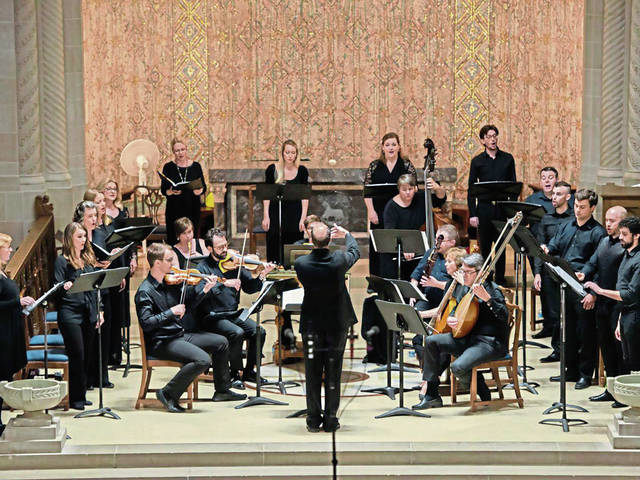Pittsburgh Camerata, Chatham Baroque combine for music of Henry Purcell
Take note when music of Henry Purcell is being performed. He thrived at the end of the 17th century and is widely regarded as the greatest English composer until the end of the 19th century.
Yet he died young and was overshadowed a generation later in England by its immigrant German composer George Frideric Handel, composer of “Messiah.”
Fame is a notoriously unreliable guide to quality, a point often proven in today’s celebrity culture. Like the work of Hugo Wolf in the field of lieder (German art songs), the delights of Purcell’s music exemplify the vivid rewards awaiting those who venture beyond ultra-famous artists.
Mark Anderson will conduct the combined forces of Pittsburgh Camerata and Chatham Baroque in concerts devoted to Purcell’s two Odes for St. Cecilia’s Day Nov. 16 and 17 at two Pittsburgh locations. The strings of Chatham Baroque will be supplemented by viola, bass, oboes, trumpets, timpani and keyboard.
“Love, life and the cosmos are intertwined and inspired by this patron saint,” says Chatham Baroque violinist Andrew Fouts of the Purcell Odes.
“You have to be at the top of your game when performing Purcell,” says Camerata music director Anderson. “He’s quite clever and utterly transparent.”
Purcell came from a musical family and enjoyed rapid professional success. He was particularly gifted at setting words to music, but his instrumental music is wonderful too, especially his compositions for consorts of viols.
He wrote two glorious Odes for St. Cecilia’s Day. Odes, poems of praise, were particularly popular in Purcell’s day and often set to music. He also wrote birthday odes and funeral odes for the English court.
Purcell was 24 when he wrote “Welcome to All the Pleasures” in 1683 to a text by Christopher Fishburn. The opening section paints a happy picture of music leading to other pleasures — all aspiring to universal harmony.
“A lot of people will recognize the overture and the solo for countertenor ‘Here the Dieties approve,’ ” says Anderson. He’s glad the soloist will be Jay Carter, “an exquisite singer who will perform the alto part in both Odes we’re presenting.
“Hail Bright Cecilia” was written in 1692, three years before the composer’s death.
“It’s a bit grander,” says Anderson. “It’s in 13 movements as opposed to seven. The solos take on the character of instruments and the choral parts are pretty colorful, especially the final chorus, which is florid and full of variety. Typically for Purcell he contrasts small subgroups of players with full ensemble to lend an operatic aspect to the music.”
Anderson says Purcell’s setting of the text is fantastic.
“ ‘The Fife and all the Harmony of War’ section is really pictorial. Purcell was a master of text painting, both vocally and instrumentally. He’s a master of that, sometimes more subtly than other composers.”
“It’s a real joy and treat for Pittsburgh Camerata to be able to do this with Chatham Baroque. They’re the best in the game,” says Anderson.
Mark Kanny is a Tribune-Review contributing writer.
Remove the ads from your TribLIVE reading experience but still support the journalists who create the content with TribLIVE Ad-Free.

